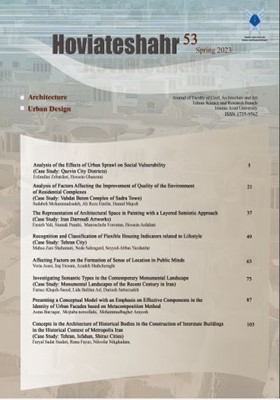Recognition and Classification of Flexible Housing Indicators related to Lifestyle (Case Study: Tehran)
Subject Areas : architectureMahsa Zare Shahamati 1 , Neda Sahragard monfared 2 , Seyed-Abbas Yazdanfar 3 *
1 - M.A.Department of Architecture,School of architecture and environmental design, Iran university of Science and Technology, Tehran, Iran.
2 - Assistant professor, School of architecture and environmental design, Iran university of Science and Technology, Tehran, Iran
3 - Associate professor, School of architecture and environmental design, Iran university of Science and Technology, Tehran, Iran
Keywords: Lifestyle, Spatial organization, flexible housing, demographic changes,
Abstract :
Housing has always been a context to satisfy diverse human needs based on social, climatic, cultural and economic changes. In this age, rapid development in technology and human sciences has resulted in different lifestyle changes and new demands requiring appropriate responses. On the other hand, the increasing efforts of traders to speed up the construction process have led to further reduced quality and neglect of housing. This is the reason why in this era, modern man urgently needs a space appropriate to his lifestyle, a home in which a person can respond to such rapid changes because a person during her life may change her place of residence according to the conditions, economically, socially, culturally and in terms of changes in family structure. Flexible housing can be considered a solution to diverse aspects of human life. It can provide a scheme to meet the demands of residents. This study, in response to three questions about the relationship between the spatial organization of housing and the lifestyle of residents. Secondary understanding of the factors affecting flexible housing and how it relates to lifestyle, thirdly priorities for different types of flexible solutions depending on lifestyle.This investigation aimed to classify and prioritize flexible housing criteria in relation to lifestyle. The design of this study was the analytical–descriptive method. First, library studies were conducted, followed by accurate Internet search and library studies. A wide range of research on these fields has been collected and analyzed. Strategies of flexible housing and spatial organization were extracted and categorized. As well as lifestyle, components were examined. A thorough questionnaire defined the priorities of the relationship between flexibility criteria and lifestyle, the sample size of the study was 416 residents of the Tehran Province.Data were analyzed using SPSS software, and Pearson’s correlation test was performed to determine the significance. Results demonstrated that the correlation relationship between neutral space (p-value * 0.538) and lifestyle is the heist priority. Multifunctional space (p-value* 0.481) stands in the second order. Partition able (p-value** 0.432) in housing is the next priority. Among the factors of the neutral space, the possibility of multiple functions and handling personal affairs in family reunification are the preferred strategies over others. Combinability with 0.417 and extendibility with 0.396 also indicate a weak relationship compared to other characteristics, while separately in the flexibility section, regardless of lifestyle, extendibility had a higher priority, but with the effect of proximity propositions. The home of a married child to the paternal home, spending time with the family and having a private space for each family member that affects lifestyle and development has diminished the importance of this component. Another reason partitionable is preferable to extendibility is the possibility of multifunctional space and personal affairs with the family. Demographic changes are the basic factor of lifestyle effects on designing housing to meet the aged people and children’s requirements. In addition, three design techniques for spatial organization are established in previous works.
_||_

